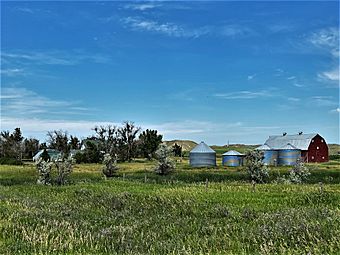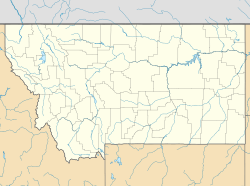Vogt–Nunberg Farm facts for kids
The Vogt–Nunberg Farm is a special place in Wibaux, Montana, that shows us what farming was like a long time ago. It's listed on the National Register of Historic Places because it's a great example of a farm from the early 1900s that grew many different things. It was added to this important list on April 10, 2008.
Quick facts for kids |
|
|
Vogt–Nunberg Farm
|
|
 |
|
| Location | 7262 Montana Highway 7, Wibaux, Montana |
|---|---|
| NRHP reference No. | 08000269 |
| Added to NRHP | April 10, 2008 |
Contents
A Look Back at the Vogt–Nunberg Farm
The Vogt–Nunberg Farm is a really important example of how farms operated in eastern Montana during the early 1900s. It shows how families managed to grow many different crops and raise various animals to make a living.
Starting a New Life in Montana
In 1910, a 20-year-old named John Vogt arrived in the Beaver Valley. This was during a big "homesteading boom," when many people moved to Montana to claim land and start farms. People were told that Montana had "good soil, good climate, good schools, [and] good markets." They also heard about new "dry-land farming" methods. This meant they could grow lots of crops without needing to water them, which was a big deal.
Not everyone claimed land directly from the government. The Northern Pacific Railroad owned a huge amount of land in Montana, about 13.3 million acres! They got this land from the government to help pay for building their railroad across the country. The railroad wanted new customers, so they sold their land easily to anyone who wanted to buy it.
John Vogt's brother, Jacob, had already started a homestead nearby. So, in 1911, John decided to buy his farm from the Northern Pacific Railroad.
Building the Farm and Family
After buying the land, John Vogt hired a local builder named Joe Novantey. Joe built a two-story house for John. He also built the most important building on the farm: a large cattle barn. This barn was 73 feet long and 35 feet wide. It was built using a method called "balloon framing." This way of building used milled lumber (wood cut into specific shapes) instead of big, heavy timbers. It was a common way to build on the Great Plains.
John also built other important buildings for his farm. These included a chicken coop, a feed house, and a hog shed. Having all these different buildings shows that John had a "diversified operation." This means he didn't just grow one type of crop or raise one type of animal. He did many different things to make sure his farm was successful.
In 1917, John married Charlotte Bott. Together, they faced tough times, like droughts (when there wasn't enough rain) and low prices for their crops and animals. In 1929, they sold the farm to Alfred and Victoria Nunberg.
Surviving Hard Times: The Nunberg Family
The Nunberg family took over the farm just as the Great Depression was starting. This was a very difficult time for many people, with little money and few jobs. But the Nunbergs were smart and hardworking. They survived by raising many different things:
- Pigs
- Chickens
- Sheep
- Beef cattle
- Dairy cattle
- Wheat
- Barley
- Oats
- Hay
They also found a creative way to earn extra money. They hosted community dances in the large hay loft of their barn! Even though times were hard, Alfred and Victoria raised nine children. They also worked hard to improve their farm and buy more land.
A Family Legacy Continues
In 1958, the Nunbergs' son, Fred, took over the farm. He continued to work the land and raise animals actively until 1995. The Vogt–Nunberg Farm stands as a testament to the hard work and cleverness of these farming families in Montana.



